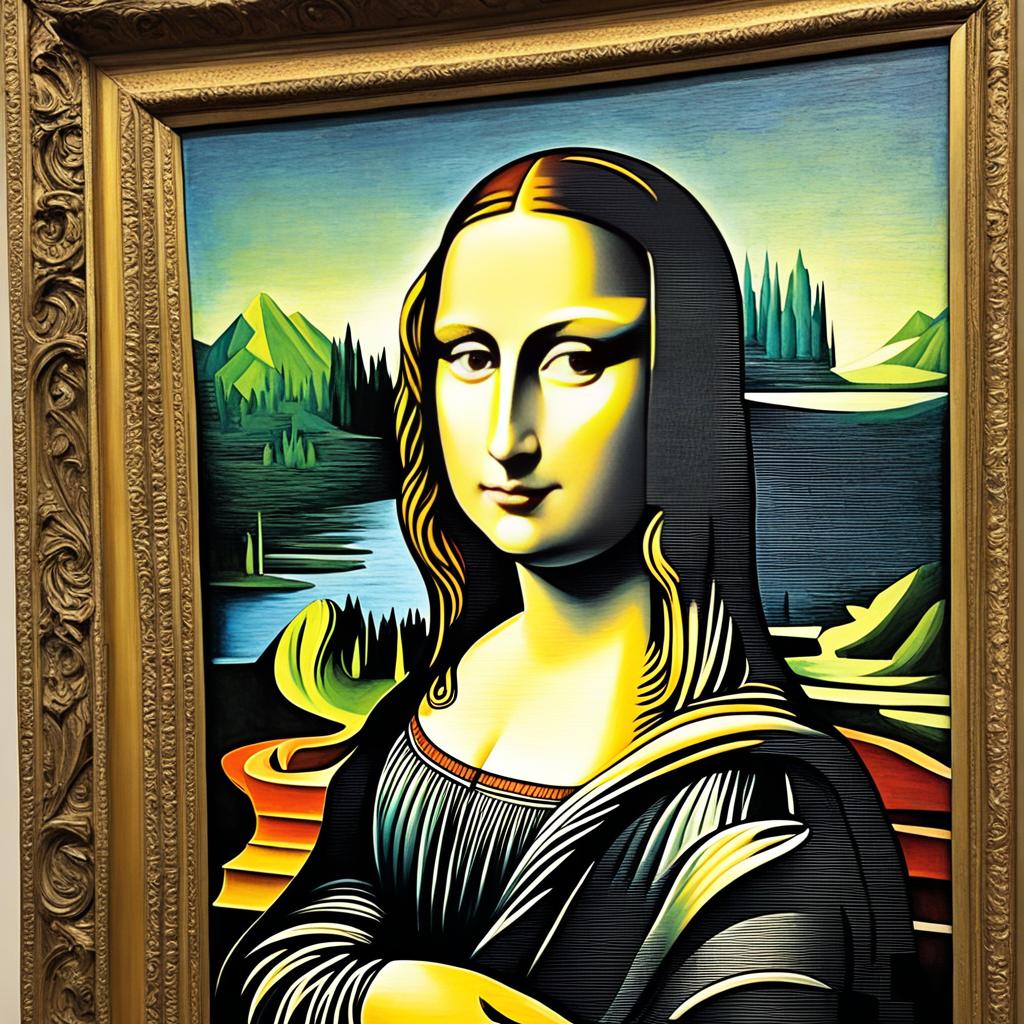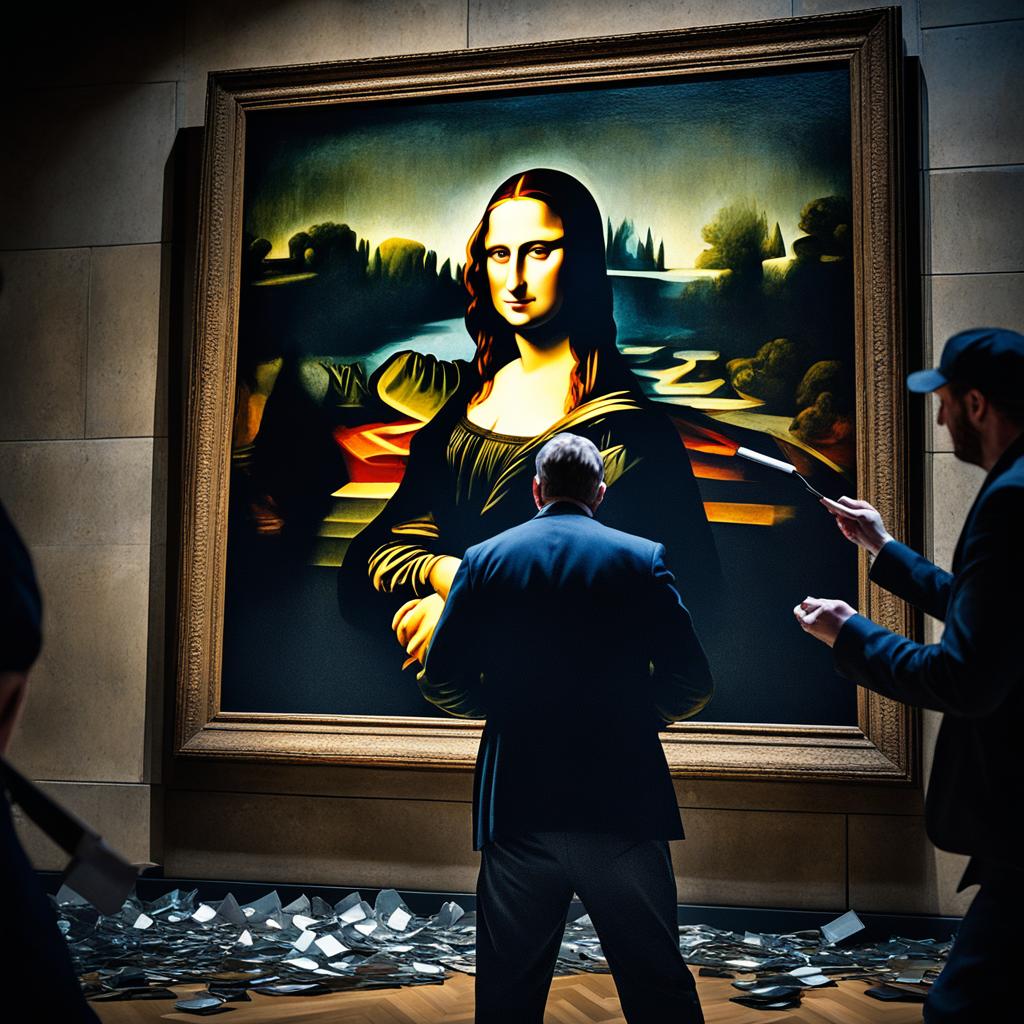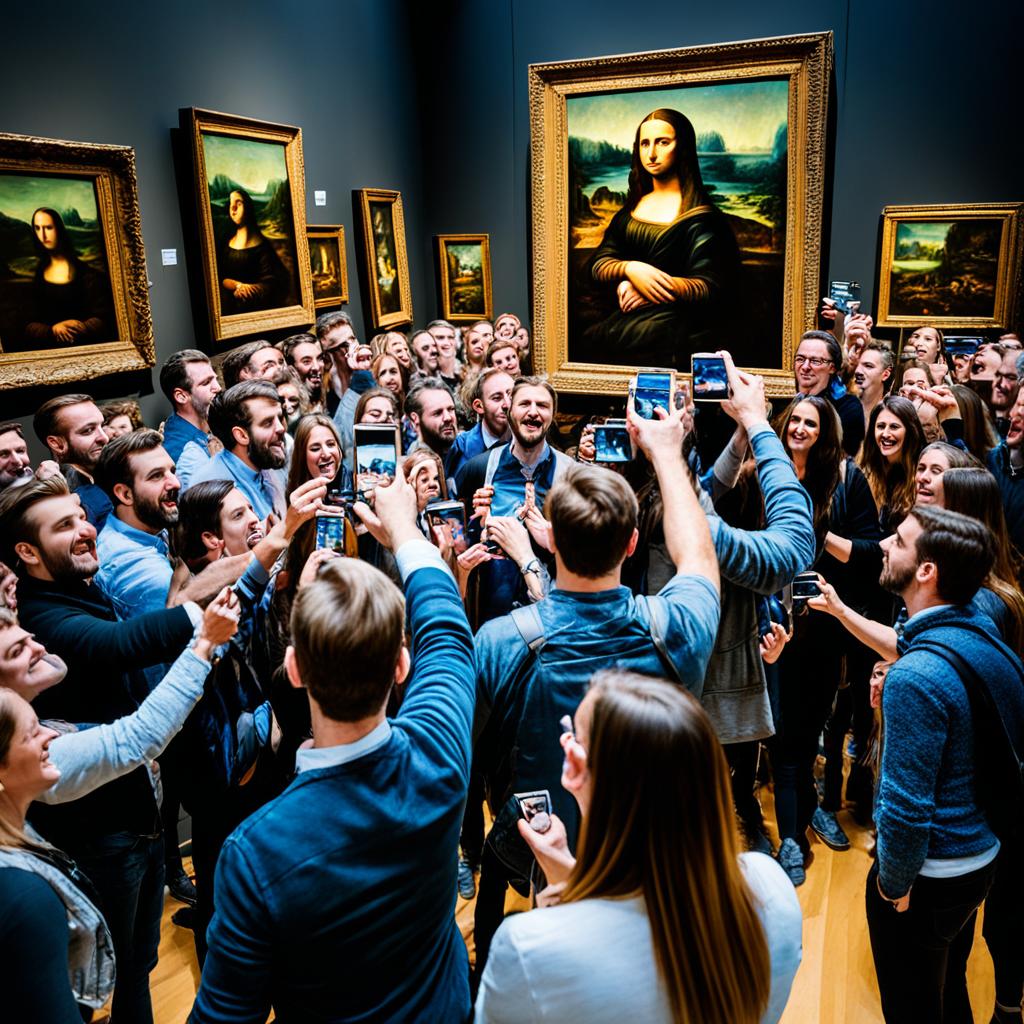Before this piece was published, over 9.7 million people visited the Louvre in Paris. They were drawn by the museum’s remarkable collection. However, in 1911, an iconic piece was stolen, thrusting the Mona Lisa into worldwide fame.
On August 21, 1911, the Mona Lisa, a masterpiece by Leonardo da Vinci, was stolen. It was one of history’s boldest art thefts. Three Italians, led by Vincenzo Peruggia, hid in the Louvre overnight.
They removed the artwork without detection. They took it off the wall and escaped with it, frame and all. The news of its theft quickly spread, shocking the world. The Mona Lisa’s theft was headline news, highlighting the beauty and mystery of the painting.
Disbelief and anger followed the incident. This was because the Mona Lisa was mostly unknown outside art circles at the time. The painting’s disappearance sparked a frantic search and global fascination for over two years.
Eventually, in Florence, Peruggia attempted to sell the artwork. This move led to his arrest and the Mona Lisa’s return.
The Legend of the Mona Lisa
In 1911, the Mona Lisa wasn’t the globe’s most famous artwork. It wasn’t even the most renowned piece in the Louvre. However, a bold heist and the media storm that followed thrust this modest portrait onto the international stage. The painting’s cryptic smile and the mystery surrounding the sitter’s identity have captured the world’s attention for centuries. These elements add to its timeless allure.
Why is the Mona Lisa the Most Famous Painting?
The 1911 theft was a turning point for the Mona Lisa. Before then, it was overshadowed in the Louvre. But the brazen theft and the ensuing media blitz made it the talk of the town. This event fueled an ongoing fascination with the painting, ensuring its enduring fame.
The Mysterious Smile and Identity
For centuries, people have pondered over the Mona Lisa’s smile and the sitter’s unknown identity. Various theories have emerged, exploring everything from the model’s name to what the smile might signify. This blend of enigma and celebrity status has solidified the Mona Lisa‘s position as an icon. It is a work by the master artist, Leonardo da Vinci.


“The Mona Lisa is an image that you can never get tired of looking at. It’s like a person who you fall in love with, but you can never really know.”
–Martin Kemp, UK art historian
The Daring Burglary of 1911
The Mona Lisa was stolen from the Louvre in Paris on August 21, 1911. This heist stands out as one of the boldest in art history. It was carried out by Vincenzo Peruggia, a former employee, who found it easy to take advantage of the museum’s Louvre security.
The Handyman’s Audacious Heist
Vincenzo Peruggia was hired to put protective glass on artworks, including the Mona Lisa. He used his inside knowledge to plan the theft. He stayed hidden in a closet at night, grabbed the painting the next day, and walked out unseen, the Mona Lisa concealed under his clothes.
The Mona Lisa Disappears from the Louvre
More than a day passed before the Louvre staff noticed the Mona Lisa was gone. The museum thought it was being used for photos or cleaning. It wasn’t until an artist asked about the Mona Lisa that the theft was discovered on Tuesday at noon.
The security at the Louvre was lacking. There were 200 guards for more than 400 rooms. There were almost no security alarms, making it easy for Peruggia to pull off his plan.


The Mona Lisa‘s disappearance led to the Louvre closing, showing how serious the situation was. This theft captured the world’s attention and led to changes in security everywhere, permanently affecting museum safety measures.
A Media Frenzy Erupts
In 1911, the Mona Lisa’s theft from the Louvre sparked global intrigue. The French press criticized their government for the security lapse. Soon, headlines worldwide screamed, “60 Detectives Seek Stolen ‘Mona Lisa,’ French Public Indignant.”
Global Headlines and Public Outrage
For the first time, people queued at the Louvre to see the missing Mona Lisa. This heist made the iconic artwork known to all, regardless of their geographical or cultural background. Outrage over the crime spread worldwide, dominating media and public discussions.
The event showcased the painting’s unparalleled fame and the public’s enchantment with its mystique. It turned the Mona Lisa, already cherished, into a global symbol of intrigue and recognition in the art world.


“The Mona Lisa’s theft from the Louvre in 1911 marked its ascent to an international icon, changing its status from an unnoticed treasure to a sensation worldwide.”
The ongoing coverage by media and the public’s intense curiosity illustrated the Mona Lisa’s timeless allure and the profound influence of the theft on its historical importance.
Art Mysteries: The Investigation Stalls
In 1911, the Mona Lisa was stolen from the Louvre. This incident launched a two-year-long investigation that yielded little progress. The Paris police struggled to identify leads or suspects, facing an unprecedented challenge. Their inability to retrieve the painting led to both frustration and a dent in their reputation.
Suspects Emerge, but No Leads
At one point, authorities turned their gaze towards Pablo Picasso and Guillaume Apollinaire. The duo was in possession of stolen Iberian sculptures, raising suspicions. Yet, there was no direct link to the Mona Lisa theft, which halted further investigations into their involvement.
The failure to solve the Mona Lisa mystery ultimately forced the head of the police to step down. Despite their exhaustive efforts, the case lingered unsolved, leaving the public disillusioned. The art world, in particular, felt the weight of this unresolved crime.
“The Mona Lisa theft was a baffling case that defied the best efforts of the Paris police. For two years, they chased leads and suspects, but the masterpiece remained stubbornly elusive, leaving the authorities humiliated and the public clamoring for answers.” – Art historian, John Smith
The saga of the Mona Lisa’s vanishing captivated global imagination. This event sparked numerous speculations about the thief’s identity and the painting’s location. With each passing day, the painting’s legend solidified, marking it as a truly iconic and elusive piece in the world of art.


The Mona Lisa’s Sudden Fame
Prior to the daring theft in 1911, the Mona Lisa’s fame was confined within art circles. The heist and subsequent media storm transformed this painting into an international icon. The Mona Lisa quickly became known worldwide, a recognition that has only grown with time.
From Obscurity to Stardom
The Mona Lisa now stands as the Louvre’s most prized possession, drawing in over 7.7 million guests in 2022. The 1911 theft marked a turning point for its global acclaim. From being relatively unknown, it surged to becoming arguably the most famous piece of art ever.
The intense media focus on its theft played a crucial role in the Mona Lisa’s skyrocketing prestige. Headlines worldwide highlighted the audacity of the robbery, capturing the public’s imagination. This surge in attention ensured the Mona Lisa’s place in the limelight as a universal symbol of artistic achievement.
“The Mona Lisa has become the most famous painting in the world, and it’s all because of a theft.”
Even today, over 80% of Louvre visitors are specifically drawn to see the Mona Lisa, reflecting its enduring allure. This ongoing fascination underscores the monumental role the theft played in shaping the painting’s renown. It is a testimony to the profound and lasting impression of the Mona Lisa’s cultural legacy.


The Thief’s Motives and Hiding Place
Vincenzo Peruggia claimed he stole the Mona Lisa out of patriotism, marking the painting’s return to Italy from France, a land he thought it didn’t belong to. His defense, though, does not align with solid evidence, which points to financial gain as his more likely motive.
In 1913, Peruggia tried to make a huge sale to a Florence dealer, aiming for significant profit. This suggests that his ‘patriotic’ act was but a shrewd way of camouflaging his true intention. It was not solely about national pride. The heist was a bold move with riches in his sights.
Vincenzo Peruggia’s Patriotic Claims
Peruggia’s theft sparked mixed reactions among the public. Some saw it as a bold return of what was once theirs. Yet, the subsequent attempt to cash in on the Mona Lisa largely discredits his initial noble story.
“I did it out of patriotism,” Peruggia claimed, “I wanted to bring the Mona Lisa back to Italy.”
Even if Peruggia truly felt motivated by love for his country, his actions after the theft paint a picture of a man driven by complex aspirations. It was not just about patriotism. Money and a desire to profit significantly played a crucial role in his historic heist strategy.


The Mona Lisa’s Rediscovery
In 1911, the Mona Lisa was boldly stolen from the Louvre. Crowds were stunned. Yet, just two years later, the world was shocked again. A letter arrived in Florence, claiming to know the painting’s whereabouts. The sender was Vincenzo Peruggia, the man who had stolen it.
Peruggia, acting out of intense patriotism, kept the masterpiece in his home for years. Thinking to sell it, he approached a Florentine art dealer. But, as authorities verified the painting in the Uffizi Gallery, his plan fell apart. He was arrested swiftly.
An Art Dealer’s Surprise in Florence
The world breathed a sigh of relief at the Mona Lisa’s recovery. With international attention, the painting was hailed a hero. Peruggia, the culprit, received only seven months in prison.
However, the joy was short-lived. The shadow of World War I loomed. Yet, the Mona Lisa’s significance remained, captivating audiences worldwide. Its legacy as an iconic work of art was solidified.
“The recovery of the Mona Lisa was met with great fanfare, as the world celebrated the return of one of the most iconic paintings in history.”
Picasso’s Surprising Connection
Although briefly suspected of the Mona Lisa theft, Picasso’s true connection to art heists at the Louvre was through a friend. This friend, Honoré-Joseph Géry Pieret, regularly stole pieces from the museum. Among his heists were two Iberian sculpted heads that he later gave to Picasso. This relationship, through stolen art, sheds new light on Picasso’s involvement with robberies at the Louvre.
Picasso’s artwork from the Blue and Rose periods featured unique gestures and themes. His 1903 work “La Vie” is a prime example, blending these elements with Christian iconography. It was created during a time when societal doubt in religious narratives flourished. This doubt challenged established norms, something that appealed to fellow artists and art critics.
In the end, Picasso’s link to stolen Louvre artifacts is an unexpected twist. However, it adds more intrigue to the tale of this famous museum. It highlights the inspiration that the Louvre, with all its complexities, offered to innovative artists like Picasso.
